Thimphu - The capital city (2,334 m)
Thimphu, the capital city of Bhutan, is nestled in a picturesque valley surrounded by mountains. Known for its unique blend of traditional Bhutanese architecture and modern development, Thimphu offers a charming mix of ancient monasteries, bustling markets, and government buildings. The city's vibrant culture is reflected in its festivals, such as the lively Tshechu celebrations, and its commitment to preserving Bhutan's rich heritage while embracing sustainable development. Thimphu serves as the political, economic, and cultural heart of Bhutan, embodying the country's unique blend of tradition and progress.
1. Tashichho Dzong:

Tashichho Dzong, meaning "the fortress of the glorious religion," is a majestic historical monument located on the northern edge of Thimphu, along the banks of the Wang Chu River. Serving both religious and administrative functions, it is a symbol of Bhutan's cultural heritage, showcasing fine Bhutanese architecture with detailed artistic woodwork. Surrounded by mountains and lakes, Tashichho Dzong reflects the rich history and spiritual life of Bhutan.
2. Memorial Chorten:
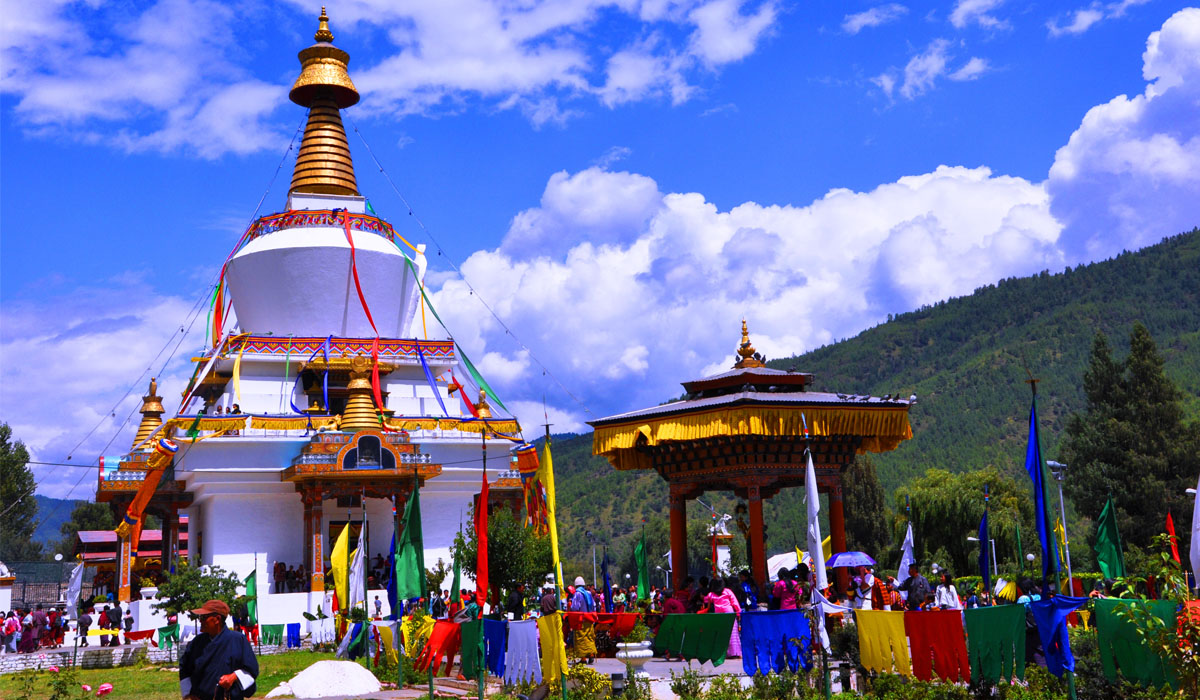
The Memorial Chorten, also known as the Thimphu Chorten, is a prominent landmark in Bhutan's capital city of Thimphu. This magnificent structure was built in 1974 in memory of the third King of Bhutan, Jigme Dorji Wangchuck, often referred to as the "Father of Modern Bhutan." Unlike other chortens, which typically house relics, the Memorial Chorten stands as a symbol of world peace and contains a large number of Buddhist statues and religious texts. Its whitewashed walls, crowned with a golden spire, make it a striking sight against the backdrop of the city.
The chorten is a central part of daily life for many Bhutanese, who visit to perform their daily prayers and rituals. Elderly devotees can often be seen circumambulating the chorten, spinning prayer wheels, and chanting mantras, adding to the spiritual atmosphere of the site. The Memorial Chorten serves not only as a place of worship but also as a community gathering point, embodying the deep-seated Buddhist traditions and the collective memory of the Bhutanese people.
3. Buddha Point:
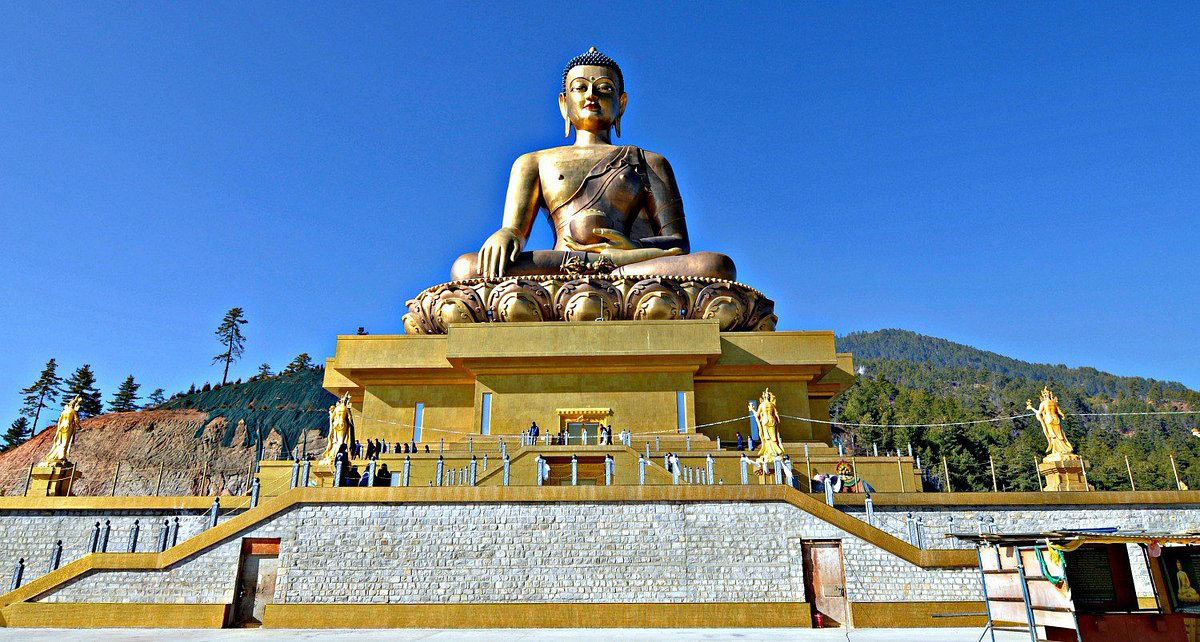
Buddha Point, also known as Kuensel Phodrang, is a prominent landmark in Thimphu, Bhutan, featuring a massive statue of Buddha Dordenma. Standing at 169 feet, it is one of the largest Buddha statues in the world. The statue, made of bronze and gilded in gold, houses over 125,000 smaller Buddha statues inside. Situated atop a hill, Buddha Point offers panoramic views of the Thimphu Valley, making it a popular destination for both tourists and locals seeking tranquility and spiritual solace.
The construction of the Buddha Dordenma statue commemorates the 60th anniversary of the fourth King Jigme Singye Wangchuck and fulfills a prophecy foretold by yogi Sonam Zangpo. The site not only serves as a symbol of peace and prosperity but also embodies the country's devotion to Buddhism. Visitors to Buddha Point can enjoy the serene environment, meditate, and appreciate the intricate artistry of the statue and its surrounding park.
4. Semtokha Dzong:
Semtokha Dzong is a historic fortress built in 1629 by Shabdrung Ngawang Namgyal. It is considered one of the oldest dzongs in the country and played a crucial role in consolidating Bhutan as a nation-state. Situated on a strategic ridge overlooking the Thimphu Valley, the dzong served both religious and administrative functions. Today, it houses the Institute for Language and Cultural Studies, preserving Bhutan's rich cultural heritage. Its architecture, featuring traditional Bhutanese motifs and intricate woodwork, reflects the dzong's historical significance and enduring legacy.
5. National Institute of Zorig Chusum:
The National Institute of Zorig Chusum is dedicated to preserving and promoting traditional Bhutanese arts and crafts. It offers comprehensive training in the "thirteen arts and crafts of Bhutan," which include painting, sculpture, woodwork, and weaving, among others. Established in 1971, it plays a crucial role in safeguarding Bhutan's cultural heritage and ensuring its continuation through education and skill development.
6. Changangkha Lhakhang:
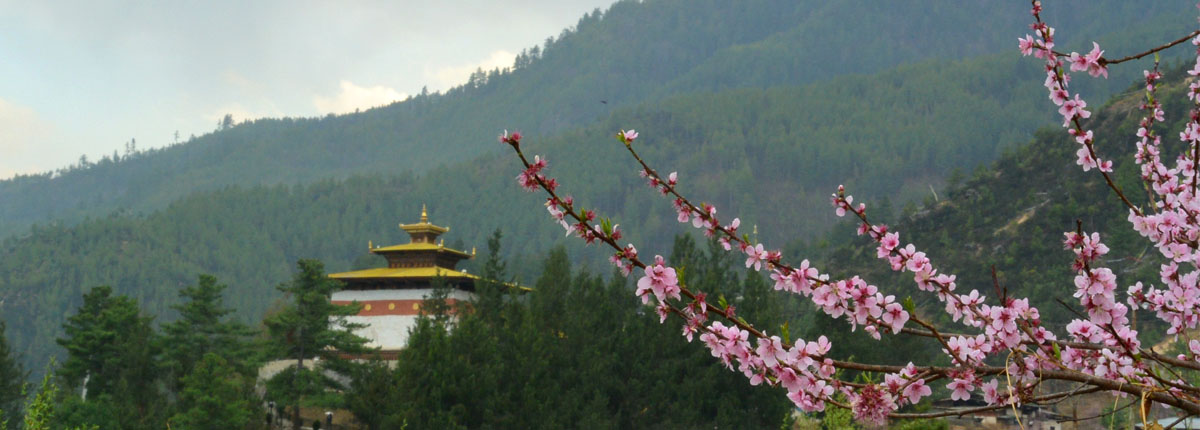
Changangkha Lhakhang is a historic Buddhist temple perched on a ridge above the city. It offers panoramic views of the valley and surrounding mountains. The temple is renowned as a place where newborn babies are brought to receive blessings and names from the resident lama, believed to grant them protection and good fortune throughout their lives. Its serene ambiance, intricate Bhutanese architecture, and cultural significance make it a cherished landmark in Bhutanese religious and social life.
7. National Library:
Visit the National Library, opened in 1967 to preserve ancient Dzongkha texts and house an extensive collection of Buddhist literature, including works dating back several hundred years. It serves as a repository for thousands of old religious books, manuscripts, and the wooden blocks used for printing. An altar in the entrance lobby features statues of historic figures such as Zhabdrung Ngawang Namgyel, Pema Lingpa, and Guru Padmasambhava. The National Library is dedicated fully to preserving and promoting the rich literary, cultural, and religious heritage of our country.
8. Royal Textile Academy Of Bhutan:
The Royal Textile Academy of Bhutan is a cultural institution dedicated to preserving and promoting Bhutanese textile arts. Located in Thimphu, the capital city, it serves as a museum, educational center, and research hub focused on the rich tradition of weaving and textile craftsmanship in Bhutan. The academy showcases a diverse collection of traditional textiles, offers workshops to educate visitors about weaving techniques, and plays a crucial role in safeguarding Bhutan's cultural heritage related to textiles.
9. Thangtong Dewachen Zilukha Nunnery:
The nunnery and monastery are located in Zilukha, overlooking Tashichho Dzong and situated just a few minutes away from the town. The monastery was constructed in 1976 by the emanation of Drupthop Thangtong Gyelpo, renowned for building iron bridges. Together, these sites symbolize the merging of Bhutan’s spiritual past, its evolving present, and the challenges of the future.
10. Pangri Zamba The School Of Astrology:
Pangri Zamba, the School of Astrology in Thimphu, Bhutan, is a revered institution where traditional Bhutanese astrology is taught and practiced. Situated in the capital city of Thimphu, this school plays a crucial role in preserving and promoting the ancient astrological traditions of Bhutan. Students learn about celestial observations, the interpretation of horoscopes, and the application of astrological principles in various aspects of Bhutanese culture and society. The school serves as a hub of learning and expertise in astrology, contributing significantly to the cultural and spiritual heritage of Bhutan.
11. Takin Preserve:
The Takin Preserve of Bhutan serves as a dedicated habitat for the takin, Bhutan's national animal, a unique and rare mammal found in the Eastern Himalayas. The preserve offers visitors the chance to observe these fascinating creatures in their natural environment, surrounded by the scenic beauty of Bhutan's mountainous landscape. It also plays a crucial role in conservation efforts to protect the takin species and promote awareness about Bhutan's rich biodiversity.
12. Centenary Farmer's Market:
The Centenary Farmers’ Market, also known as “The weekend market,” is situated along the bank of the Wang Chu River. Come Thursday, vendors from all over the country start pouring in and remain until Sunday night to sell their wares.
Walking around this market, you’ll notice the air transitioning from pungent to sweet to aromatic depending on the produce on display—from dried fish to Dachi (cheese) balls, seasonal vegetables and fruits, and spices. Across the market and the footbridge, one can find a collection of clothing and handicraft stalls. There are wooden bowls, prayer beads, amulets, prayer wheels, and more on offer. If you look carefully, you could find some treasures amid the heap.
13. Chagri Monastery:
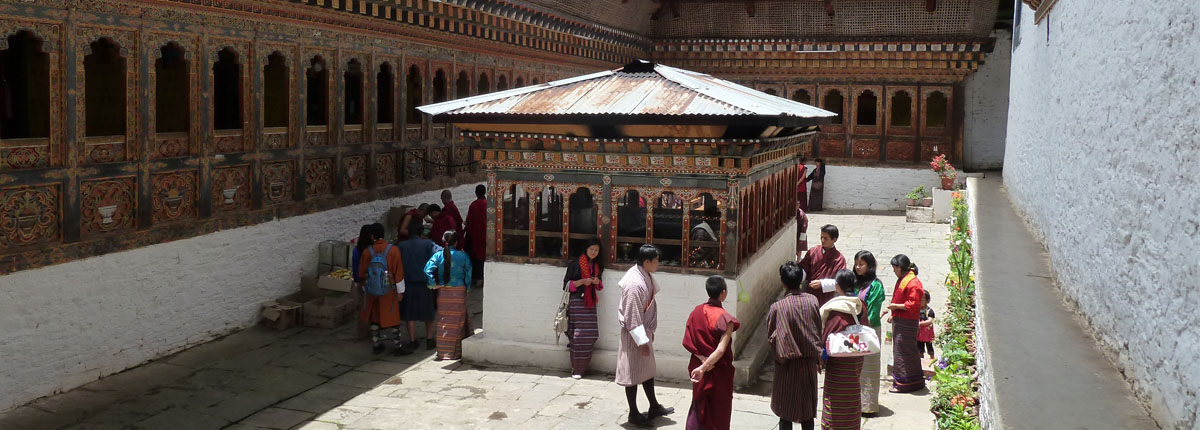
Chagri Monastery is a prominent Buddhist monastery situated on a hilltop overlooking the Thimphu Valley. Founded in 1620 by Zhabdrung Ngawang Namgyal, the unassuming exterior of Chagri Monastery belies its historical significance as one of Bhutan's oldest and most sacred sites for meditation and religious studies. The monastery's serene surroundings and traditional architecture make it a cherished destination for spiritual retreats and contemplation.
14. Tango Monastery:
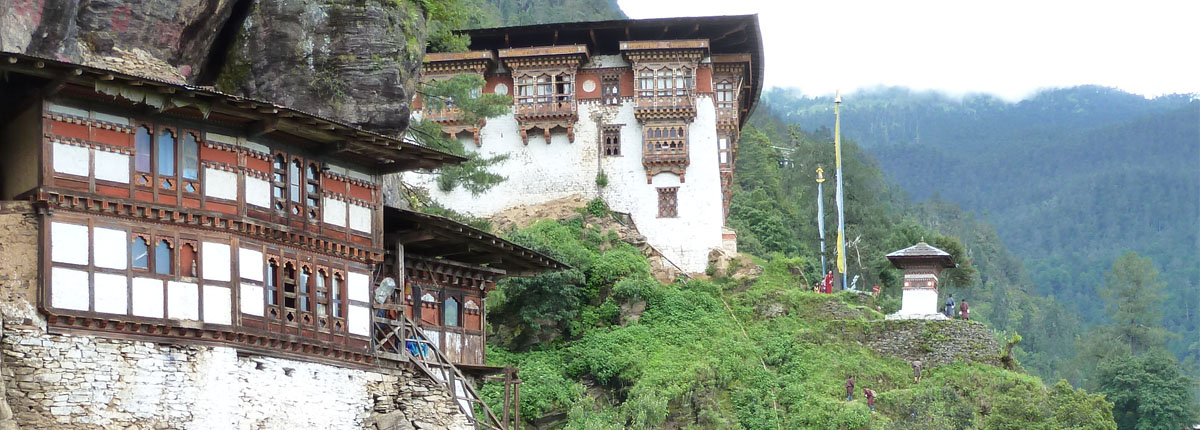
Tango Monastery is a prominent Buddhist monastery and educational institution founded in the 13th century by Lama Gyalwa Lhanampa. It is renowned for its stunning architecture, scenic location amidst the Himalayas, and its role as a center for Buddhist studies and meditation retreats. Tango Monastery remains a significant spiritual and cultural landmark in Bhutan, attracting pilgrims and tourists alike who seek tranquility and religious insights.
15. Dochula Pass:
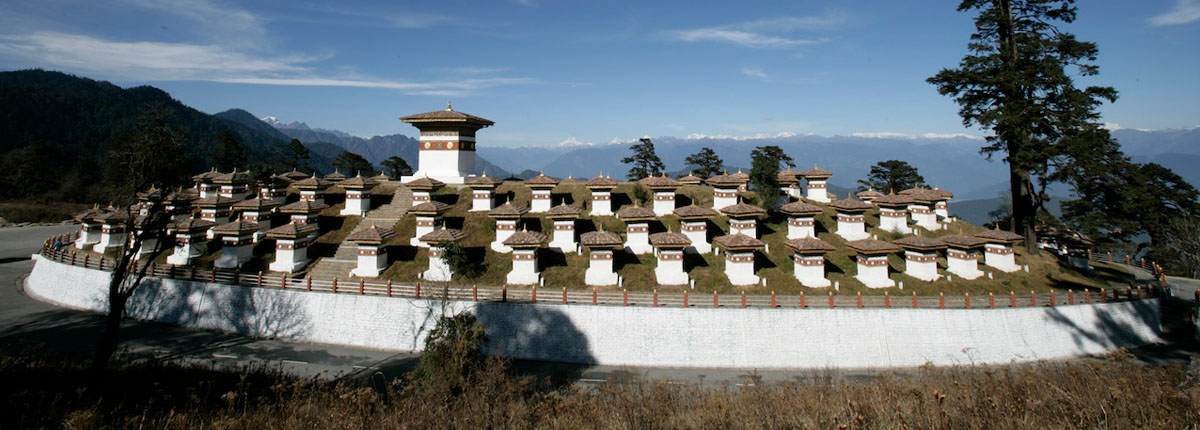
Dochula Pass is a scenic mountain pass located on the road from Thimphu to Punakha in Bhutan. It is renowned for its stunning panoramic views of the Himalayas, featuring 108 memorial chortens (stupas) built by the Queen Mother to honor Bhutanese soldiers. The pass is often shrouded in mist and offers a serene atmosphere amidst prayer flags fluttering in the wind, making it a popular stop for both locals and tourists alike.